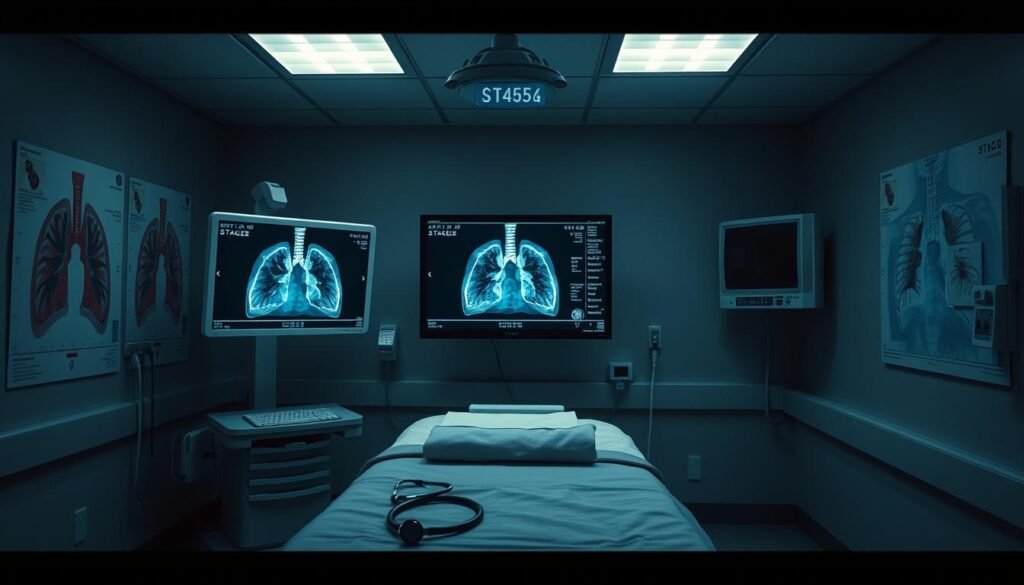Did you know that only about 5% of patients with stage 4 lung cancer live beyond five years? This fact shows the tough battle these patients face. Stage 4 lung cancer means the cancer has spread far from the lungs. Patients need to tackle it using various treatments.
Despite the tough diagnosis, medical advances offer hope. Now, there are more ways to treat stage 4 lung cancer. This includes chemotherapy, targeted therapies, and immunotherapy. These treatments aim to improve life spans and the quality of life. It’s important for patients and their families to understand these advanced lung cancer treatments. This way, they can make better choices during such a challenging period.
Key Takeaways
- Stage 4 lung cancer significantly impacts survival, with only 5% of patients reaching five years post-diagnosis.
- Understanding treatment options for stage 4 lung cancer is essential for improving outcomes and quality of life.
- Advancements such as targeted therapies and immunotherapy are reshaping cancer care.
- Informed decision-making is crucial in navigating the complexities of treatment.
- Each patient’s treatment plan may vary based on individual needs and genetic factors.
Understanding Stage 4 Lung Cancer
Stage IV lung cancer is also known as metastatic lung cancer. It’s a critical stage where cancer spreads from the lungs to other parts of the body. For example, it may reach the brain, bones, or liver. Such spreading changes how doctors can treat the patient and affects their outcomes.
Lung cancer comes in two main types: non-small cell lung cancer (NSCLC) and small cell lung cancer (SCLC). NSCLC makes up about 85 to 90 percent of all lung cancer cases. The rest are SCLC. It’s crucial to understand these types to better manage stage IV lung cancer. For instance, NSCLC is categorized into stages, with stage IV showing cancer has spread.
Although cure is not possible for stage IV NSCLC, there are treatments to improve life quality. Treatments aim to ease symptoms and extend life. Doctors consider the patient’s age, health, and tumor traits to choose the right treatment. Options include chemotherapy, targeted therapy, or immunotherapy.
Targeted therapies attack cancer cells’ specific changes. Drugs like osimertinib and alectinib target these mutations in cells. For small cell lung cancer, doctors often use chemotherapy and radiation together.
Immunotherapy is another key treatment. It boosts the body’s own defense against cancer. Whether it works can depend on the PD-L1 protein in the tumor. The TNM staging system helps doctors understand the cancer’s extent. This knowledge is crucial for planning the treatment path for advanced lung cancer patients.
Symptoms of Stage 4 Lung Cancer
People with stage 4 lung cancer face many challenges that affect their daily lives. Key symptoms of this advanced stage include:
- Persistent cough: Tumor growth can block airways, making it hard to clear fluids.
- Hemoptysis: Coughing up blood is a scary symptom that usually appears later.
- Chest pain: This occurs when cancer spreads to other parts of the body.
- Fatigue: A deep tiredness is common, made worse by muscle loss and less hunger.
- Shortness of breath: Fluid around the lungs can make breathing hard. Treatments like draining the fluid might help.
Stage 4 lung cancer symptoms can also show up in other organs as the cancer spreads. Brain involvement can bring on headaches or weakness. Treating these issues may include using radiation.
Oxygen therapy often helps with breathlessness. Medicines can also make breathing easier. Managing pain well is key as symptoms get worse. This can involve radiation therapy and medication.
Patients also go through emotional and spiritual shifts. They may pull back from friends or think a lot about death. Some might reflect on their beliefs or feel they’re seeing loved ones who’ve passed away. It’s vital to notice these symptoms for both care and treatment. Understanding the full scope of treats for spreading lung cancer helps make better choices as symptoms change.
| Symptom | Description |
|---|---|
| Persistent Cough | Difficulty clearing fluids due to tumor growth in airways. |
| Fatigue | Extreme tiredness caused by cancer cachexia and treatment effects. |
| Shortness of Breath | Often stemming from fluid build-up around the lungs. |
| Pain | Resulting from cancer spread to other regions. |
| Neurological Symptoms | Headaches or weakness if the cancer spreads to the brain. |
Diagnosis of Stage 4 Lung Cancer
The journey begins with an accurate stage 4 lung cancer diagnosis. These tests include X-rays, CT scans, and MRIs. They help doctors see if cancer exists and how far it has spread. It’s vital to find cancer early because stage 4 means it has reached other areas beyond the lungs.
A tissue biopsy is also important to confirm lung cancer. This test shows the type of cancerous cells present. Additionally, lung cancer stage 4 management relies on genetic testing. This helps find specific changes in the genes, leading to the most effective treatment for each patient.
Knowing all about the diagnosis helps patients explore their treatment paths better. For those with stage 4, cancer might have spread to the brain, bones, and more. Understanding these details helps patients feel more confident. It also helps them find the best treatments available.

| Diagnostic Method | Description |
|---|---|
| X-ray | An initial test to identify abnormalities in the lungs. |
| CT Scan | Provides detailed cross-sectional images of the lungs. |
| MRIs | Offers high-resolution images, particularly useful in assessing brain metastases. |
| Biopsy | Confirms the presence and subtype of lung cancer through tissue sampling. |
| Genetic Testing | Identifies mutations to guide personalized treatment plans. |
Treatment options for stage 4 lung cancer
Patients with stage 4 lung cancer face tough challenges. They need to know all treatment options. It’s key to find the best treatments to help increase survival and keep a high quality of life.
Chemotherapy: An Overview
Chemotherapy is a main treatment for stage 4 lung cancer. It often uses drug combos like cisplatin and gemcitabine. Since it targets fast-dividing cancer cells, it’s used after surgery too. Patients should talk to their doctors about when and how to best use it.
Targeted Therapy: Gene-Based Treatment
Targeted therapy offers a personalized treatment plan. It attacks genetic mutations in cancer cells. For instance, drugs that target EGFR or ALK mutations show good results. Knowing your genetic details helps pick the most effective treatment, improving chances of success.
Immunotherapy: Boosting Your Immune Response
Immunotherapy is a hopeful choice in fighting advanced lung cancer. It uses agents like pembrolizumab to boost the immune system to fight cancer. This method works well against non-small cell lung cancer. It gives patients more ways to battle the disease.
Surgery: When It’s Considered
Surgery is less common for stage 4 lung cancer, but still an option. It’s considered if the cancer hasn’t spread much. Procedures like wedge resection or lobectomy could be used. After surgery, chemo or radiation might be given to attack any leftover cancer.
For a detailed look at treatments, visit treatment options for stage 4 lung cancer. Learning about all the options helps patients make informed choices that suit their health needs.
| Treatment Type | Common Drugs/Options | Purpose |
|---|---|---|
| Chemotherapy | Cisplatin, Gemcitabine | Kills rapidly dividing cancer cells |
| Targeted Therapy | EGFR Inhibitors, ALK Inhibitors | Targets specific genetic mutations |
| Immunotherapy | Pembrolizumab | Enhances body’s immune response |
| Surgery | Wedge Resection, Lobectomy | Removes localized cancer |
Advanced Lung Cancer Treatments: New Developments
The treatment world for advanced lung cancer is changing fast. This brings new hope for those with stage 4 lung cancer. Now, there are therapies designed just for a person’s genetic type. These have been making patient results better. Research has been focusing a lot on clinical trials and personalized medicine.
Clinical Trials: Exploring Novel Options
Clinical trials are opening doors to new treatments for stage 4 lung cancer. They test new drugs and mixtures of current treatments. At places like Memorial Sloan Kettering Cancer Center, they’re looking at Durvalumab in trials. Patients here can try out new methods that aim to raise survival rates in advanced lung cancer.
Personalized Medicine: Tailoring Treatment
Personalized medicine is changing how we fight advanced lung cancer. Doctors use genetic tests to find specific changes in tumors. Then, they pick out therapies that match the patient’s own genes. For example, Sotorasib works well for certain gene changes. This approach is a big deal in treating stage 4 lung cancer, making treatments more effective.

| Treatment Type | Description | Example Medications |
|---|---|---|
| Immunotherapy | Stimulates the immune system to fight cancer cells. | Durvalumab, Pembrolizumab, Atezolizumab |
| Targeted Therapy | Uses drugs to target specific mutations in cancer cells. | Sotorasib, Alectinib, Osimertinib |
| Clinical Trials | Research studies testing new treatments. | Novel vaccines, combination therapies |
Research and clinical practice advancements continue to grow. They promise better treatments for stage 4 lung cancer. With new therapies and personal care, patients have real hope. This fight against the disease looks more hopeful than ever.
Managing Side Effects of Treatment
Treatment for stage 4 lung cancer can bring lots of side effects. Patients might feel nausea, get very tired, or not feel like eating because of chemotherapy, targeted therapy, and immunotherapy. It’s super important to handle these side effects well. This makes the tough journey a bit easier for patients.
Knowing that there are ways to manage these side effects gives patients power. Things like changing meds, eating differently, and helpful therapies can make a big difference. For example, it’s essential to manage shortness of breath. Especially with complications like pleural effusion. Using treatments such as pleural tap or pleurodesis helps a lot. And indwelling pleural catheters can be a short or long-term fix, depending on what the patient needs.

Many patients also deal with pain. They might use pain meds. Or they find that meditation and relaxing helps with pain control too. Knowing how important these methods are makes a big difference in caring for stage 4 lung cancer.
Poor appetite and losing weight are big issues too. They happen because of the cancer and the treatment. Having special nutritional plans and support from dietitians helps patients eat better. This helps them be stronger and feel better overall.
| Common Side Effects | Management Strategies |
|---|---|
| Nausea | Medication adjustments, ginger tea, small meals |
| Fatigue | Sleep hygiene, light exercise, balanced diet |
| Breathe difficulties | Pleural tap, pleurodesis, breathing exercises |
| Pain | Pain medication, meditation, physical therapy |
| Poor appetite | Supplemental nutrition, dietary counselling |
In conclusion, it’s crucial to manage side effects for stage 4 lung cancer treatment. Being informed and part of treatment decisions helps overall. It makes life better and improves treatment success.
Support and Palliative Care for Patients
Being told you have stage 4 lung cancer is very hard. Support goes beyond medical treatments. It includes caring for your emotional and mental health. Palliative care helps lessen tough symptoms like nausea, pain, and worry. This improves life quality as patients go through their treatment.
Importance of Emotional Support
Feelings of fear, depression, and anxiety are common. Counseling and support groups can really help. They offer a way to share feelings with others who understand. Palliative care teams have social workers, psychologists, and nurses. They work together to give full support. Talking with this team can make patients feel less alone during their treatment.
End-of-Life Care Options
Looking into end-of-life care becomes important as the illness advances. Hospice care focuses on comfort and the best quality of life. Patients can get palliative care at home, in hospitals, or in nursing homes. It fits what they need. Care includes managing pain, helping with daily tasks, and supporting families emotionally. To learn more, check out palliative care for lung cancer. It shows the ways to provide comfort and respect during tough times.
Stage IV Lung Cancer Care: Multidisciplinary Approach
Stage 4 lung cancer treatment requires teamwork from various healthcare experts. This multidisciplinary cancer care includes oncologists, radiologists, surgeons, and care specialists. Together, they create specialized treatment plans that meet medical and emotional needs.
Lung cancer is a leading cause of cancer deaths globally. Most patients are diagnosed in advanced stages. Using a team approach improves adherence to treatment guidelines and speeds up treatment start times.
Studies show that team care boosts survival and life quality for stage III and IV lung cancer patients. Patients in these settings are more likely to get active treatments and fully utilize surgery, chemo, and radiation. Their treatment aligns with lung cancer management standards.
Here’s a quick look at the perks of team-based stage 4 lung cancer care:
| Benefits of Multidisciplinary Care | Description |
|---|---|
| Enhanced Survival Rates | Improves patient outcomes, especially for stage IV. |
| Timely Treatment | Shortens the wait from diagnosis to treatment. |
| Patient-Centric Recommendations | Treatment plans fit guidelines better. |
| Comprehensive Support | Covers medical and emotional needs. |
| Increased Participation in Clinical Trials | More patients join important clinical trials. |
A multidisciplinary approach not only improves treatment results but also enhances patient care. With many lung cancer patients facing muscle loss, a comprehensive approach is crucial. It boosts survival chances and improves life quality.
Stage 4 Lung Cancer Survival Rates and Prognosis
Understanding the lung cancer survival rates offers insights for those with stage 4 lung cancer. The outlook for patients at this stage is much more complex than in earlier stages. For metastatic non-small cell lung cancer (NSCLC), the five-year survival rate is around 9%. Small cell lung cancer (SCLC) has a lower rate of about 3%.
Survival rates depend on many factors including the type of cancer and its spread. For NSCLC, the stage 4 cancer prognosis is 9% for widely spread cancer. SCLC survival rate for extensive spread is 3%. This shows why early detection and treatment are key.
| Cancer Type | Original Location | Spread to Nearby Tissues | Spread Throughout the Body | All Stages Combined |
|---|---|---|---|---|
| Small Cell Lung Cancer (SCLC) | 30% | 18% | 3% | 7% |
| Non-Small Cell Lung Cancer (NSCLC) | 65% | 37% | 9% | 28% |
Age significantly affects stage 4 cancer prognosis. Those under 50 have an 11% survival rate. For ages 50-64, it decreases to 7%, and for those over 65, it’s just 4.7%. Typically, patients live four months after diagnosis.
Patients with stage 4 lung cancer can also receive palliative care. This care aims to improve their quality of life. It helps provide comfort and ease symptoms.
Conclusion
Dealing with stage 4 lung cancer is tough. Yet, there are many treatment options that can help. Talking openly with doctors helps patients choose the best treatment for them.
It’s important to manage symptoms and improve the quality of life for these patients. New therapies, like platinum-based chemotherapy and EGFR inhibitors, offer hope. To learn more about these, visit detailed resources.
Being proactive and starting palliative care early can make a big difference. Learning more and getting support helps ease the hardship of stage 4 lung cancer. This way, patients can focus on better outcomes and a better quality of life.